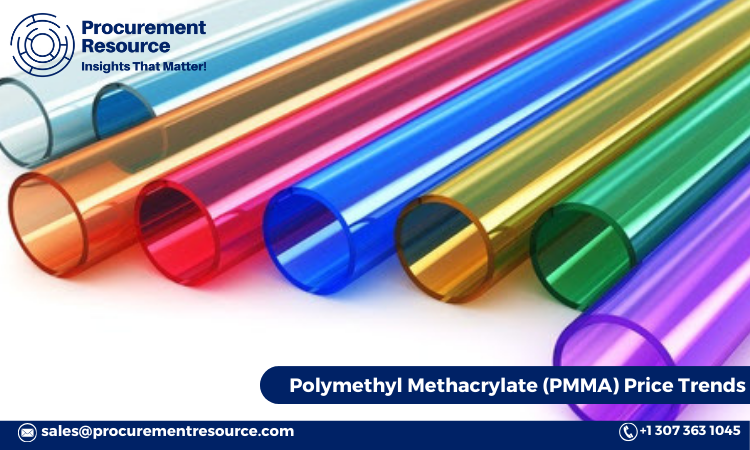PMMA, known as acrylic or plexiglass, is a transparent thermoplastic used in automotive headlamps, signage, lighting fixtures, medical devices, and construction glazing. It’s produced via polymerization of methyl methacrylate (MMA), so its price follows MMA feedstock movements, energy costs, and global polymer demand. The manufacturing process – typically via bulk or solution polymerization – adds variables like reactor costs and monomer conversion efficiency.
Request for the real time prices: https://www.procurementresource.com/resource-center/polymethyl-methacrylate-price-trends/pricerequest
Latest Price Overview
The Polymethyl Methacrylate Price Trend lately reflects modest upward pressure. Demand from automotive (lights, displays) and building construction (windows, facades) has remained solid. Supply-side factors include capacity adjustments in China, maintenance in key MMA conversion plants, and energy cost increases in Europe and Southeast Asia.
Producers note steady spot inquiries but longer lead times due to operating rates. FOB offers from Asia are competitive, but freight rates and carbon levies can affect CFR pricing in import-heavy regions.
News and Market Updates to Watch
Events currently steering the PMMA landscape include:
- Maintenance schedules at major MMA and PMMA facilities
- Fluctuations in MMA monomer feedstock costs tied to methacrylic acid or acetone derivatives
- Energy and carbon pricing, especially in Europe, impacting production margins
- Demand from architectural glazing projects and medical-grade applications
- Supply chain tightness or freight bottlenecks affecting delivery timelines
Policymaker actions on optics and medical material standards may also influence demand for specialty PMMA grades.
Historical Curve and Market Signals
Looking at historical PMMA prices shows patterns shaped by feedstock, demand cycles, and production events:
- Feedstock tying: MMA price swings often serve as leading indicators for PMMA movements.
- Construction cycle alignment: Building booms or auto production ramps can drive short-term firming.
- Supply disruptions: Planned shutdowns or unplanned outages at polymer plants create visible rally points.
Overlaying PMMA price charts with MMA and energy benchmarks helps distinguish cost-push from demand-pull patterns.
Forecast Outlook
In the near term, PMMA prices appear range-bound, with upside risk linked to MMA feedstock or energy spikes. Medium-term forecasts hinge on:
- Global construction and automotive recovery
- Additions or maintenance downtime at MMA/PMMA facilities
- Energy cost trends and regional regulatory impacts
- Evolution of medical device and specialty grade demand
Using scenario models—base aligned with stable feedstock, high reflecting disruption or strong demand, and low featuring easing inputs—enables more grounded procurement planning.
Regional Insights and Analysis
Asia Pacific
A dominant PMMA producer region, especially China, India, and South Korea. FOB Asia levels are shaped by MMA cost trends and competitive capacity.
Europe
Producers face higher energy and environmental costs. Demand from automotive glazing and architectural segments supports steady volumes.
North America
Stable demand from display and appliance sectors. Imports from Asia compete on price but need to account for freight, duties, and quality specs.
Middle East & Africa
Growing demand in construction and signage. Imports from Asia and Europe, with landed costs influenced by freight and regional duties.
Latin America
Emerging usage in automotive components and building façades. Supply comes from Asia or local capacity in Brazil; currency swings affect landed costs.
Market Insights: Supply Chain and Demand Drivers
- Feedstock sensitivity: MMA implies all — its cost movements deeply shape PMMA pricing.
- End-use diversity: Beyond construction, medical and display markets create demand buffers.
- Production cost variance: Energy, reactor efficiencies, and polymer grade adjustments factor into suppliers’ pricing strategies.
Procurement teams generally mix contracts for baseline supplies with spot flexibility to capitalize on market softening.
Database, Chart, Historical Data, and Methodology
Our PMMA datasets include:
- Interactive price charts for FOB, CFR, and domestic benchmarks on daily, weekly, and monthly cadence
- Downloadable historical data spanning multiple years
- Feedstock correlations (MMA, energy, acetone derivatives) for elasticity studies
- Forward scenarios with base, high, and low pricing outlooks for 12–24 months
Data comes from supplier quotes, trade publications, and verified market intelligence for reliability.
Visit the Polymethyl Methacrylate Price Trend to view dashboards, download time series, and compare forecast curves.
Practical Buying Strategy for PMMA
- Keep an eye on MMA feedstock price fluctuations for advance signals
- Match procurement timing with construction or automotive project cycles
- Secure freight or import pathways ahead of expected logistics cost spikes
- Differentiate planning for optical-grade versus general purpose grades to manage cost vs quality
How Procurement Resource Supports this Category
Procurement Resource gives full-spectrum market insights for PMMA, including:
- Regional price comparison and landed cost views
- Feedstock-to-product cost modeling
- Import/export flows with HS code-level tracking
- Ready visuals for procurement strategy and budgeting discussions
These tools ensure your Polymethyl Methacrylate Price Trend analysis stays aligned with your procurement strategy and risk profile.
Contact Information
Company Name: Procurement Resource
Contact Person: Ashish Sharma (Sales Representative)
Email: sales@procurementresource.com
Location: 30 North Gould Street, Sheridan, WY 82801, USA
Phone:
UK: +44 7537171117
USA: +1 307 363 1045
Asia-Pacific (APAC): +91 1203185500
Connect With Us Online:
https://www.linkedin.com/company/procurement-resource-official



Leave a Reply